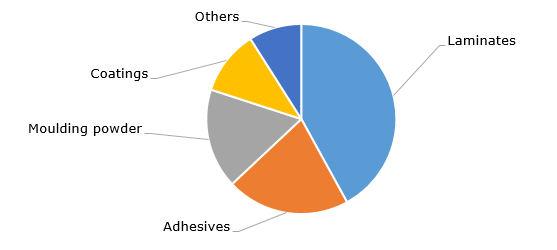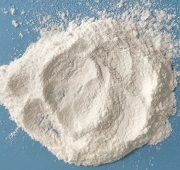Melamine (1,3,5-triaminotriazine) is a nitrogen-rich organic compound, that was originally synthesized from cyanamide but is now more commonly produced using urea. Melamine is widely used in both industrial and domestic applications. Its primary role is in the manufacture of laminates and construction materials, particularly high-pressure laminates (HPL) and low-pressure laminates (LPL), which provide durable and glossy surfaces for furniture, flooring and related products. The reaction between melamine and formaldehyde produces cross-linked resins, which have better mechanical and thermal properties when compared to phenolic and urea resins. These melamine-formaldehyde resins are used in laminate panels, adhesives, coatings, glues, flame retardants, moulding powders (especially for injection-moulded items like plastic kitchenware and dinnerware), as well as in paper, textiles and more.
Structure of the melamine-formaldehyde resins market by application

In the concrete industry, sulfonated melamine is employed as a superplasticizer, improving the material’s strength, fluidity and durability. Melamine also has applications in pharmaceuticals. Each of these uses presents an opportunity to showcase corporate sustainability efforts. For instance, BASF produces a sound-absorbing melamine resin foam that has the lowest carbon footprint currently available on the market among similar materials.
Although melamine was once investigated for use as a fertilizer and livestock feed additive due to its high nitrogen content, it was ultimately deemed unsuitable because of its slow decomposition and low bioavailability. Alarmingly, melamine has been illicitly added to food products to artificially inflate apparent protein levels, posing significant health risks. These dangers became particularly evident following major food safety incidents related to melamine, most notably when the contamination with melamine affected pet food in the United States in 2007 and infant milk formula and other dairy products in China in 2008. Melamine is associated with harmful effects on human health, specifically on the endocrine and reproductive systems. As a result, its use is subject to strict regulatory controls, especially within the European Union, posing considerable compliance challenges.
Another aspect of EU regulation refers to melamine imports from China, which has been a longstanding issue for European melamine producers. China remains the world’s largest producer of melamine, accounting for over 68% of global production capacity. As of February 2025, a new tariff structure was implemented for melamine imports into the EU. This change is expected to raise the cost of Chinese melamine imports, potentially improving profit margins for European melamine manufacturers.
In the United States, Cornerstone Chemical Company steadily increased melamine prices throughout 2024, for example, by approximately US$441 per tonne in May 2024 and US$220 per tonne in September 2024. The most recent increase, as of March 2025, was around US$110 per tonne of melamine. Cornerstone Chemical Company continues efforts to meet domestic demand, which may help insulate the U.S. market from the impacts of the ongoing trade conflict. In the first half of 2025, U.S. demand for melamine has been weakened by high mortgage interest rates, which have negatively affected the new housing construction sector. However, this may be partially offset by growth in the home renovation market.
Although the melamine market has been under pressure in recent years due to a challenging macroeconomic environment and subdued demand, some manufacturers have performed well. For example, OCI Global reported a 41% year-on-year increase in melamine sales volumes in the second half of 2024 compared to the same period in 2023. The company recorded a total melamine sales volume of approximately 100 thousand tonnes in 2024. OCI Global attributed this strong performance in its melamine-related business to the improvement in market conditions.
Find a detailed analysis of the melamine market in the in-demand research report “Melamine: 2025 World Market Outlook and Forecast up to 2034”.
